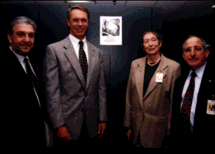 SGI VP Robert Ewald and
SGI VP Robert Ewald and Dr. Milton Halem greet
Dr. Simpson before the
dedication ceremony.
 SGI VP Robert Ewald and
SGI VP Robert Ewald and
Dr. Milton Halem greet
Dr. Simpson before the
dedication ceremony.
Goddard Space Flight Center (GSFC) held a dedication ceremony on May 14 to officially name NASA's fastest supercomputer "jsimpson" after Dr. Joanne Simpson, chief scientist for Meteorology at GSFC. Naming a supercomputer after a living individual is a rare honor. Simpson was chosen for her pioneering work using computers in meteorological research.
Simpson was a pioneer in cloud modeling, producing
the first one-dimensional model and the first cumulus model on a computer.
In addition to being Goddard's chief meteorologist, she also serves as project
scientist for the Tropical Rainfall Measuring Mission (TRMM), the first
spacecraft dedicated to measuring tropical and subtropical rainfall through
microwave and visible infrared sensors.
"When we see things like comets named after people, that is glamorous,"
said Simpson at the dedication ceremony. "But a computer, particularly
one of this power and capability, is an enabler for many people to do exciting
work."
Also speaking at the ceremony were host Dr.
Milton Halem, Chief, Earth
and Space Data Computing Division; Joseph
Rothenberg, GSFC Director; Lee Holcomb, Director, Aviation Systems Technology
Division, Office of Aeronautics, NASA Headquarters; and Robert Ewald, Executive
Vice President, Silicon Graphics, the CRAY T3E's manufacturer.
 Dr. Joanne Simpson,
with Dr. Milton Halem, Robert Ewald, and Joseph Rothenberg after officially
unveiling the Cray T3E supercomputer.
Dr. Joanne Simpson,
with Dr. Milton Halem, Robert Ewald, and Joseph Rothenberg after officially
unveiling the Cray T3E supercomputer.
 The CRAY T3E named for Simpson currently has
256 processors, 33 billion bytes of memory, and a peak speed of 153 billion
floating-point operations per second (gigaFLOPS). This summer it will be
upgraded to 512 processors, 66 billion bytes of memory and 306 gigaFLOPS
peak, placing the GSFC CRAY T3E among the top 15 supercomputers in the world.
It would take every person in the United States punching calculators over
30 years to equal what the CRAY T3E can do in one second.
The CRAY T3E named for Simpson currently has
256 processors, 33 billion bytes of memory, and a peak speed of 153 billion
floating-point operations per second (gigaFLOPS). This summer it will be
upgraded to 512 processors, 66 billion bytes of memory and 306 gigaFLOPS
peak, placing the GSFC CRAY T3E among the top 15 supercomputers in the world.
It would take every person in the United States punching calculators over
30 years to equal what the CRAY T3E can do in one second.
SGI/Cray installed the Cray T3E parallel computing system at GSFC's Earth
& Space Data Computing Division on March 24, 1997, in support of Grand
Challenge applications sponsored by the High
Performance Computing and Communications Earth and Space Science Project.
Visit the Glacier Bay Science Site